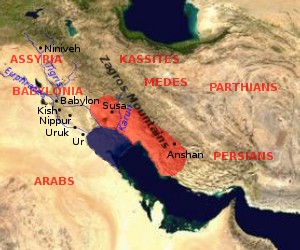The land of Elam, or Elamais to the Greeks, lay in the highlands to the immediate east of Sumeria and the adjoining region along the coast of the Persian Gulf. To its natives it was Haltamti, to the Assyrians Elamtu, and it appears as the place name of Elam in the bible. To its north lay the Zagros mountains and the city (and associated region of) of Susa, whilst eastward the coast extended to the city (and associated region of Anshan). Elam, Susa and Anshan are often considered together and referred to as Elam, although confusingly in classical times the same region was generally referred to as Susiana (after Susa). These differences reflect the predominance of one or other cities at the time. In any case, it is convenient for us to think of the entire region as ‘Elam’. During the Early Bronze Age, Elam, Susa and Anshan formed an extension of the same broad cultural region as Mesopotamia, and its cities, citizenry and armies would have been comparable in appearance if perhaps lacking wealth and sophistication to some degree. However, the Elamites spoke their own language and originally wrote it using their own script, though later an adapted form of Akkadian cuneiform was used.

Map showing extent of Elamite domains prior to the Gutian invasions.
Elamite history is more difficult to trace than that of Sumerian or Akkadian states because what records once existed were probably destroyed during the Assyrian period, so our information comes from Elam’s enemies. The earliest of these was King Enmebaragesi of Kish, whose conquest of Elam is recorded somewhat before 2500BC as part of the Sumerian King list. We do not get to firm ground with Elamite history until about 2300 BC, during the time of the Akkadian Empire. However, from the claims and counterclaims of various rulers it is obvious that there were times when Sumerian Kings extended their rule eastward over parts of Elam, and other times when Elamite Kings ruled over parts of Sumer. Eannatum of Lagash was one of those whose domain expanded to include Elam, for example. ‘Many tounged’ Hamazi – to use the epithet attributed to it in the Gilgamesh epic, was a city in Elam that briefly dominated parts of Sumeria under its king Hadanish– although no one knows exactly where this interestingly named city was.
During the reign of Sargon of Akkad (c2300BC), both Susa and Elam were conquered and brought within the Akkadian Empire. The same local rulers often continued in power, but in a subservient role, and these ‘governors’ (as they now effectively were) campaigned against neighbouring hill tribes on the Akkadian Kings behalf. After the fall of the Akkadian Empire the governor of Susa asserted the region’s independence. He was called Kutik-Inshushinak. Having proved a successful commander on behalf of the last Akkadian King, he went on to conquer Anshan to the east of Elam and united the Elamites under his rule. These achievements were soon swept away by the invasion of a barbarous people from the North – the Gutians – who went on to wreak havoc throughout Sumer and Akkad until finally defeated in about 2050BC by a resurgent Sumer led by Ur-Nammu King of Ur. The subsequent Ur III dynasty was itself overrun and destroyed by the Elamites in 2004BC under their king Kindattu.
The following four hundred years are known as the Amorite period in Mesopotamia, during which the old order was swept away and new Amorite dynasties replaced Akkadian rulers. At the beginning of the Amorite period the land must have endured a period of anarchy, with Amorites marauding and sometimes resettling old cities or founding new ones, and the Elamites attacking and taking the cities of Sumeria to the south. There must have been many battles over hundreds of years, as the Sumerian cities either fought to free themselves from foreign rule or submitted to the lordship of the Elamites. The Sumerian city of Larsa emerged as the most powerful of these remergent states, reconquering much of southern Mesopotamia and battling for control of Susa. But the Elamites certainly remained a power in the land, sacking Akkad on one occasion and plundering its temples. One can only imagine a world of politics and diplomacy in which the different Mesopotamian and Elamite states vied with each other to secure alliances and protect their own interests. However, eventually the Elamites were driven out of Mesopotamia altogether by the Babylonians under Hammurabi – the greatest of the Amorite Kings. By 1763BC the Babylonians had taken control of all southern Mesopotamia, including their former ally Larsa, and the power of Elam had been crushed.
Gaming with Early Elamites
The period in question – down to about 1500BC is known as the Old Elamite period and in terms of army lists its coincides with the Sumerian and Akkadian list (covering the Early Bronze Age down to the fall of the Third Dynasty of Ur) and Amorite Kingdoms (covering the Middle Bronze Age down to the conquest of Mesopotamia by the Kassites). No doubt there were many differences in the appearance of armies from these states over the long period concerned: differences that it is impossible for us to even imagine four thousand years later. However we do know that Elamite forces were noted for their archers, implying these made up a greater portion of their forces than in the case of their enemies. Given that Elam lay amongst a mountainous region bordered by savage hill tribes, it is also reasonable to assume that subjugated locals would have provided some of the army’s muscle – at least in the form of auxiliary or light troops. These would have included archers no doubt, but also slingers and javelinmen – the typical armaments of tribal raiders. In other respects the armies would be the same as those of the Mesopotamian states themselves as far as we can tell, and they can be represented by the same army lists.
Wondering which miniatures to collect? Look no further than the growing Cutting Edge Miniatures Early Elamite range…
View the full range

















